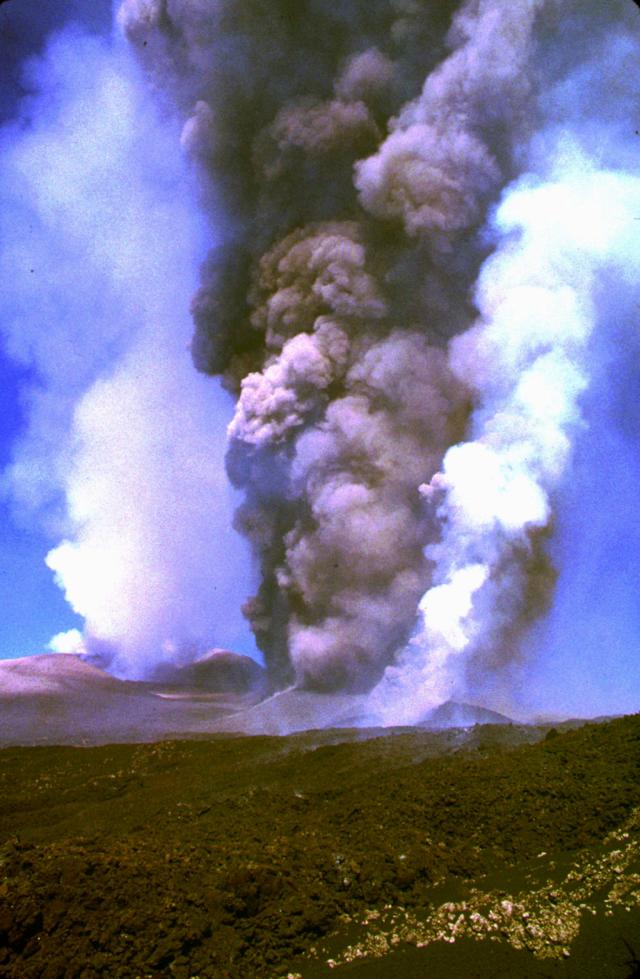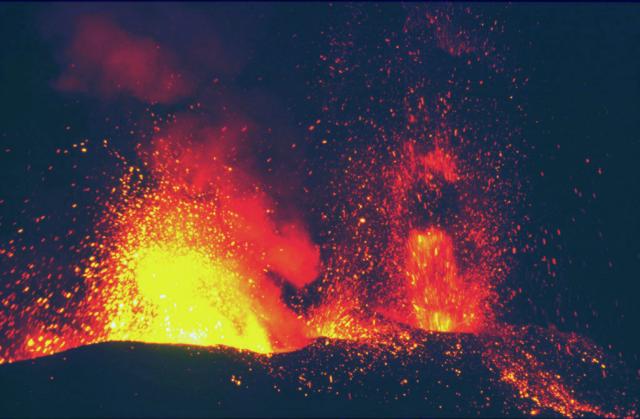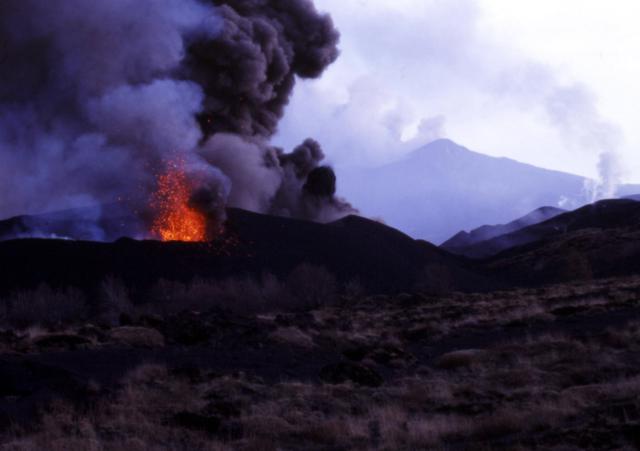Report on Etna (Italy) — November 2002
Bulletin of the Global Volcanism Network, vol. 27, no. 11 (November 2002)
Managing Editor: Richard Wunderman.
Etna (Italy) Witnesses saw N- and S-flank eruptions begin at around 0200 on 27 October
Please cite this report as:
Global Volcanism Program, 2002. Report on Etna (Italy) (Wunderman, R., ed.). Bulletin of the Global Volcanism Network, 27:11. Smithsonian Institution. https://doi.org/10.5479/si.GVP.BGVN200211-211060
Etna
Italy
37.748°N, 14.999°E; summit elev. 3357 m
All times are local (unless otherwise noted)
After the violent flank eruption of July-August 2001, Mount Etna was rather calm for more than 10 months, except for usual fumes from the four summit craters [and minor ash emissions]. In the first days of July 2002 weak magmatic activity resumed sporadically at the NE Crater with ejection of bombs that fell on the outer slopes of the cone. On 12 September explosions occurred every 2 or 3 minutes and were violent enough to throw large spatter as far as the northern rim of the Voragine (Central Crater). However, there were many days without explosive activity and, at other times, the NE Crater emitted large clouds of brownish ash. Although a magnitude 3.7 earthquake had struck the northern flank of the volcano on 22 September, subsequent days were so calm that, to these contributors, the following events came as quite a surprise.
As the National Institute of Geophysics and Volcanology (INGV) previously reported (BGVN 27:10), a seismic swarm began to shake Etna late during the evening of 26 October 2002. One observer, Maurice Aubert, happened to be in a hotel on the northern flank (at Piano Provenzana, 1,816 m elevation). There the seismic shocks were distinctly felt after midnight and rapidly reached hazardous levels. Hours later, at 0205 on 27 October, lava fountains began to play along a fissure 1-2 km up slope, but decreased at 0220 when lava flows expanded downwards.
The seismic intensity of earthquakes felt the night of the 26th ranged from II to VII or perhaps VIII. The approximate timing and seismic intensity was recorded as follows at 0030, II; at 0140, VI; at 0200, VI; at 0320, VII; and at 0343, VII or VIII. Maurice Aubert and his group hastily retreated shortly after 0320, exiting while cracks were developing through the mountain road. The last of the above-reported intensities was felt during their departure, when a strong earthquake shook their car.
Vents at ~2,700 m elevation on the southern flank (on the Piano del Lago) are here called the S2700 vents. These new S-flank vents lay just SE of the ancient cone of Monte Frumento Supino and ~800 m NW of the Laghetto cone, which appeared in 2001.
Watching the S2700 vents, Giuseppe Scarpinati saw two lava fountains develop after 0200, together with a large ash plume that drifted S. The eruptive phenomena were accompanied by strong detonations and rumblings together with continuous earthquakes that were felt in Acireale, a town at Etna's southeastern foot.
Lava flows from the northern vents invaded and over ran the flat area containing tourist facilities at Piano Provenzana and proceeded as two branches downwards through the pine trees towards Linguaglossa, a village ~10 km to the NE. The greatest damage was not the loss of all tourist facilities at Piano Provenzana, but was instead due to heavy ashfall S of the volcano, which led to closing of the Catania airport on the afternoon of 27 October.
On the morning of 28 October the S fissure had developed at least three explosive vents. A 100-to-200-m-high lava fountain, ~200 m downslope, fed lava flows that extended by more than 2 km toward the uninhabited area of Monte Nero degli Zappini (figures 97 and 98). During the day, however, the effusive activity significantly decreased, and on 29 October the lava fronts virtually stopped on the southern side, although violent degassing at the upper end of the fissure continued unabated. Sustained release of high pressure gas fed a voluminous SE-directed ash plume that reached to more than 5 km altitude. At the same time on the 29th, a large plume of white vapor was emitted at the summit from the central crater vents (Bocca Nuova, Voragine) and the NE Crater. The SE crater, the main site of the 2001 eruption, remained entirely calm.
Strong earthquakes on 29 October caused damage on the lower E flank of the mountain, particularly at Santa Venerina where some 1,000 people were left homeless. The main shock was recorded by Jean-Claude Tanguy in the SE region of the volcano (Trecastagni) at 17 seconds after 1102 (± 5 sec). Horizontal ground motions there lasted 7 to 8 seconds. The INGV reported the seismic event as M 4.4, located 8-9 km beneath Santa Venerina. Other strong shocks at 1739 and 1814 (M 4.0 and 4.1) caused walls to collapse along the road between Zafferana and Milo.
On 30 October soon after midday the Bocca Nuova vent began to emit large clouds of brownish ash. This activity culminated between 1310 and 1320, and the ash cloud merged into the still large, dark ash plume from the southern lateral vents. However, Strombolian explosive activity was still vigorous at the main explosive center, which included a group of about six vents near 2,000 m elevation (called the N2000 vents). These vents, which produced photogenic activity into the night (figure 99), lie just to the E of an old cinder cone known as Monte Ponte di Ferro (at 2,040 m elevation). Here the accumulation of pyroclasts had built a spatter rampart ~200 m long and 30 to 40 m high, the upper part of which reached 2,035 m elevation (± 5 m, measured from Mt. Ponte di Ferro using both altimeter and inclinometer).
On 31 October the wind gradually shifted from the N to the W and then SW, so that ashfall from S2700 vents affected localities NE of the volcano including Reggio di Calabria, whose airport also had to be closed. At the northern vents the lava effusion was on a waning stage, but violent explosions from the two upper vents of the N2000 group threw blocks of ancient material amid juvenile tephra (figure 100).
On 1 November all activity ceased on the northern side except for very small residual lava flows, but the S2700 upper vent appeared to enter a phase of sustained explosive activity resembling a small subplinian column that continued to cause disruptions around the volcano. It was not until 12 November at 1340 that the activity abruptly changed to typical Strombolian explosions of liquid lava clots with loud detonations. On 13 November at about 1600 a small lava flow began to trickle from the lower base of the S2700 cone. The lava effusion increased on 14 November, expanding downwards along the 27-28 October flows. Meanwhile ash emission recommenced at the S2700 crater.
This kind of eruption style is quite unusual at Mount Etna. The authors suggest that it could indicate that a considerable amount of magma has intruded into the S rift zone, which would account for strong degassing without any significant lava effusion between 2 and 13 November.
Geological Summary. Mount Etna, towering above Catania on the island of Sicily, has one of the world's longest documented records of volcanism, dating back to 1500 BCE. Historical lava flows of basaltic composition cover much of the surface of this massive volcano, whose edifice is the highest and most voluminous in Italy. The Mongibello stratovolcano, truncated by several small calderas, was constructed during the late Pleistocene and Holocene over an older shield volcano. The most prominent morphological feature of Etna is the Valle del Bove, a 5 x 10 km caldera open to the east. Two styles of eruptive activity typically occur, sometimes simultaneously. Persistent explosive eruptions, sometimes with minor lava emissions, take place from one or more summit craters. Flank vents, typically with higher effusion rates, are less frequently active and originate from fissures that open progressively downward from near the summit (usually accompanied by Strombolian eruptions at the upper end). Cinder cones are commonly constructed over the vents of lower-flank lava flows. Lava flows extend to the foot of the volcano on all sides and have reached the sea over a broad area on the SE flank.
Information Contacts: Jean-Claude Tanguy, University of Paris 6 & Institut de Physique du Globe, 94107 St. Maur des Fossés, France; Maurice Aubert, University of Clermont-Ferrand, Department of Geology, 63038 Clermont-Ferrand, France; Roberto Clocchiatti, CNRS-CEN Saclay, Lab. Pierre Süe, 91191 Gif sur Yvette, France; Santo La Delfa and Giuseppe Patané, University of Catania, Department of Geological Sciences, Corso Italia 55, 95129 Catania, Italy; Giuseppe Scarpinati,via Muggia 7, 95024 Acireale, Italy.





